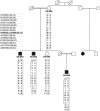Missense mutation in the ATPase, aminophospholipid transporter protein ATP8A2 is associated with cerebellar atrophy and quadrupedal locomotion
- PMID: 22892528
- PMCID: PMC3573203
- DOI: 10.1038/ejhg.2012.170
Missense mutation in the ATPase, aminophospholipid transporter protein ATP8A2 is associated with cerebellar atrophy and quadrupedal locomotion
Abstract
Cerebellar ataxia, mental retardation and dysequilibrium syndrome is a rare and heterogeneous condition. We investigated a consanguineous family from Turkey with four affected individuals exhibiting the condition. Homozygosity mapping revealed that several shared homozygous regions, including chromosome 13q12. Targeted next-generation sequencing of an affected individual followed by segregation analysis, population screening and prediction approaches revealed a novel missense variant, p.I376M, in ATP8A2. The mutation lies in a highly conserved C-terminal transmembrane region of E1 E2 ATPase domain. The ATP8A2 gene is mainly expressed in brain and development, in particular cerebellum. Interestingly, an unrelated individual has been identified, in whom mental retardation and severe hypotonia is associated with a de novo t(10;13) balanced translocation resulting with the disruption of ATP8A2. These findings suggest that ATP8A2 is involved in the development of the cerebro-cerebellar structures required for posture and gait in humans.
Figures



References
-
- Tan U. A new syndrome with quadrupedal gait, primitive speech, and severe mental retardation as a live model for human evolution. Int J Neurosci. 2006;116:361–369. - PubMed
-
- Moheb LA, Tzschach A, Garshasbi M, et al. Identification of a nonsense mutation in the very low-density lipoprotein receptor gene (VLDLR) in an Iranian family with dysequilibrium syndrome. Eur J Hum Genet. 2008;16:270–273. - PubMed
-
- Kolb LE, Arlier Z, Yalcinkaya C, et al. Novel VLDLR microdeletion identified in two Turkish siblings with pachygyria and pontocerebellar atrophy. Neurogenetics. 2010;11:319–325. - PubMed
Publication types
MeSH terms
Substances
Supplementary concepts
Grants and funding
LinkOut - more resources
Full Text Sources
Molecular Biology Databases
Research Materials

